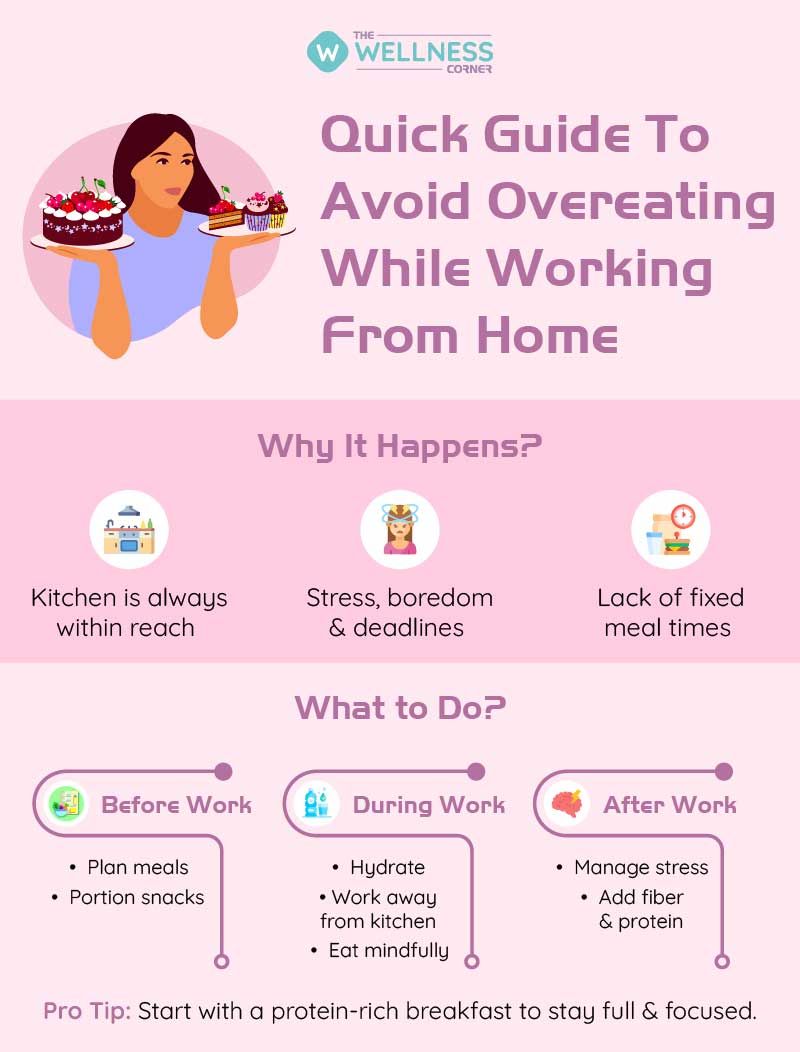6 Simple Tips To Avoid Overeating While Working From Home
1 month ago
6 minute read.

Working from home has become the new normal for many of us. While it brings plenty of perks like no long commutes, a flexible schedule, and the comfort of being in your own space; it also comes with challenges. One of the most common struggles people face is overeating.
Think about it: your kitchen is just a few steps away, your snack drawer is stocked, and no one’s around to notice if you grab that extra cookie during a Zoom call. Add in the stress of work deadlines or boredom during slow hours, it’s easy to find yourself eating more than you need.
Over time, this habit can lead to weight gain, sluggishness, digestive issues, and even poor concentration. The good news is that with some simple strategies, you can keep your eating habits in check while still enjoying the flexibility of working from home.
Here are seven simple yet powerful tips to help you avoid overeating while working remotely.

1. Create a Meal and Snack Schedule
One of the main reasons people overeat while working from home is the lack of structure. In an office, you usually follow a set routine like breakfast before leaving, lunch during the break, and maybe a coffee or snack in the evening. At home, however, the lines blur, and you may end up grazing all day without realizing it.
The solution? Set a meal and snack schedule.
- Plan your three main meals—breakfast, lunch, and dinner—at fixed times.
- Allow yourself one or two snack breaks in between, but keep them controlled.
- Stick to this routine as much as possible, even on busy days.
When your body gets used to eating at specific times, it naturally reduces random cravings. Plus, you’ll avoid the “I’ll just grab something quick” trap that often leads to unnecessary munching.
Pro tip: Use reminders on your phone or calendar to signal mealtimes. Over time, this structured approach becomes second nature.
2. Don’t Work Next to the Kitchen
Let’s be honest, the closer you are to the kitchen, the more often you’ll walk in just to “check what’s there.” And once you open the fridge, chances are you’ll grab something, even if you’re not truly hungry.
That’s why it’s important to create a physical barrier between your workspace and your kitchen.
- If possible, set up your desk in a separate room or corner away from the food.
- If your home is small, at least position your workspace so that the kitchen isn’t in direct sight.
- Keep snacks and food items out of your work area.
This simple step creates just enough resistance to make you pause and think before grabbing a snack. If you need to physically get up and walk to the kitchen, you’re more likely to ask yourself, “Am I really hungry right now?”
Pro tip: Keep a glass of water or herbal tea at your desk. Sometimes, sipping on something light is enough to curb the urge to snack.
Also Check This Recipe: Caffeine Free Herbal Tea
3. Stay Hydrated Throughout the Day
Did you know that thirst is often mistaken for hunger? Many times, when you feel like eating something, your body is actually asking for water. Working from home can make this worse, as we often forget to drink enough fluids while sitting at our desks.
To avoid unnecessary snacking, make hydration a priority:
- Keep a water bottle on your desk at all times.
- Aim for 10-12 glasses of water a day, or more if you’re active.
- Try herbal teas, infused water (with lemon, cucumber, or mint), or plain warm water for variety.
Staying hydrated not only keeps false hunger signals in check but also boosts energy, focus, and digestion.
Pro tip: Start your day with a glass of warm water before your morning coffee. It sets the tone for better hydration throughout the day.
4. Choose Smart Snacks
Let’s face it, snacking is part of the work-from-home lifestyle. The key isn’t to avoid snacks completely but to make smarter choices. Instead of chips, cookies, or sugary treats that spike your energy and then crash it, go for options that are nourishing and filling.
Some healthy snack ideas:
- Fresh fruits (apple slices, bananas, oranges, or berries)
- A handful of nuts or seeds (almonds, walnuts, pumpkin seeds, sunflower seeds)
- Yogurt with a drizzle of honey or a few chopped fruits
- Veggie sticks (carrots, cucumber, bell peppers) with hummus
- Air-popped popcorn or roasted chana (chickpeas)
These snacks provide essential nutrients while keeping your energy levels stable. They also keep you fuller for longer, reducing the urge to grab more food.
Pro tip: Pre-portion your snacks into small containers or serve a portion in a small bowl or plate instead of eating straight from the packet. This prevents mindless overeating.
Also Read: Snacks To Charge You Up

5. Eat Without Distractions
How often have you eaten lunch while replying to emails, attending a meeting, or watching Netflix? The problem with distracted eating is that your brain doesn’t fully register the food, and you end up eating more than you need.
To combat this, practice mindful eating:
- Step away from your desk when it’s mealtime.
- Sit at a table and focus on your food.
- Chew slowly, savor the flavors, and listen to your body’s fullness cues.
Even spending 15–20 minutes on a meal without distractions can make a huge difference. You’ll enjoy your food more and feel satisfied with less.
Pro tip: Use smaller plates—it tricks your mind into thinking you’re eating more, while actually controlling portion sizes.
6. Manage Stress and Boredom Eating
Finally, one of the biggest culprits behind overeating is emotional eating. Working from home often comes with stress, isolation, or boredom, and food becomes a quick comfort. Unfortunately, this leads to overeating without truly solving the underlying issue.
Here’s how you can break the cycle:
- Pause before eating: Ask yourself, “Am I really hungry, or am I stressed/bored?”
- Find alternatives: If it’s emotional hunger, try deep breathing, stretching, journaling, or stepping outside for fresh air.
- Take micro-breaks: Short breaks throughout the day help refresh your mind and reduce the urge to eat out of boredom.
- Get moving: A quick walk, a 10-minute workout, or even dancing to your favorite song can distract you from emotional cravings.
By addressing the root cause, you’ll eat only when your body actually needs fuel—not as a way to cope with feelings.
7. Add Fiber and Protein to Your Meals
One of the simplest ways to control overeating while working from home is to make your main meals more satisfying. Meals that are low in protein or fiber often leave you feeling hungry soon after, which leads to snacking and cravings.
Fiber slows down digestion and keeps your energy levels steady, while protein supports muscle health and keeps you fuller for longer. Together, they help prevent the urge to grab unnecessary food between meals.
Here’s how you can add more fiber and protein to your meals:
- Include lean protein sources like eggs, chicken, fish, tofu, beans, or lentils.
- Choose high-fiber options such as whole grains, oats, fruits, vegetables, and legumes.
- Combine both protein and fiber in every main meal for better satiety.
This combination not only curbs hunger but also improves overall nutrition, making your diet more balanced.
Pro tip: Start your day with a protein-rich breakfast like oatmeal topped with nuts and seeds, or scrambled eggs with veggies. It sets the tone for reduced cravings throughout the day.
Final Thoughts
Working from home doesn’t have to mean losing control over your eating habits. With a little planning and awareness, you can enjoy healthy, balanced meals without constant grazing.
To recap, the seven simple tips are:
- Stick to a meal and snack schedule.
- Keep your workspace away from the kitchen.
- Stay hydrated throughout the day.
- Choose smarter snack options.
- Eat mindfully without distractions.
- Manage emotional triggers like stress and boredom.
- Add Fiber and Protein to Your Meals
Remember, the goal isn’t to restrict yourself but to eat in a way that supports your productivity, health, and energy levels. By following these practices, you’ll find yourself not only eating better but also working more efficiently and feeling more balanced throughout the day.
Leave a Comment
Related Articles
Health Checks @ Home
Service
Explore
© 2025 Truworth Health Technologies Pvt. Ltd.




